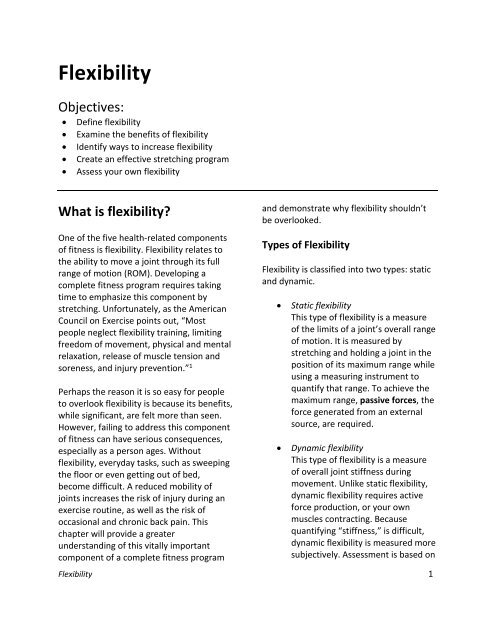Concepts of Fitness and Wellness 2e, 2018
Concepts of Fitness and Wellness 2e, 2018
Concepts of Fitness and Wellness 2e, 2018
You also want an ePaper? Increase the reach of your titles
YUMPU automatically turns print PDFs into web optimized ePapers that Google loves.
Flexibility<br />
Objectives:<br />
• Define flexibility<br />
• Examine the benefits <strong>of</strong> flexibility<br />
• Identify ways to increase flexibility<br />
• Create an effective stretching program<br />
• Assess your own flexibility<br />
What is flexibility?<br />
One <strong>of</strong> the five health-related components<br />
<strong>of</strong> fitness is flexibility. Flexibility relates to<br />
the ability to move a joint through its full<br />
range <strong>of</strong> motion (ROM). Developing a<br />
complete fitness program requires taking<br />
time to emphasize this component by<br />
stretching. Unfortunately, as the American<br />
Council on Exercise points out, “Most<br />
people neglect flexibility training, limiting<br />
freedom <strong>of</strong> movement, physical <strong>and</strong> mental<br />
relaxation, release <strong>of</strong> muscle tension <strong>and</strong><br />
soreness, <strong>and</strong> injury prevention.” 1<br />
Perhaps the reason it is so easy for people<br />
to overlook flexibility is because its benefits,<br />
while significant, are felt more than seen.<br />
However, failing to address this component<br />
<strong>of</strong> fitness can have serious consequences,<br />
especially as a person ages. Without<br />
flexibility, everyday tasks, such as sweeping<br />
the floor or even getting out <strong>of</strong> bed,<br />
become difficult. A reduced mobility <strong>of</strong><br />
joints increases the risk <strong>of</strong> injury during an<br />
exercise routine, as well as the risk <strong>of</strong><br />
occasional <strong>and</strong> chronic back pain. This<br />
chapter will provide a greater<br />
underst<strong>and</strong>ing <strong>of</strong> this vitally important<br />
component <strong>of</strong> a complete fitness program<br />
<strong>and</strong> demonstrate why flexibility shouldn’t<br />
be overlooked.<br />
Types <strong>of</strong> Flexibility<br />
Flexibility is classified into two types: static<br />
<strong>and</strong> dynamic.<br />
• Static flexibility<br />
This type <strong>of</strong> flexibility is a measure<br />
<strong>of</strong> the limits <strong>of</strong> a joint’s overall range<br />
<strong>of</strong> motion. It is measured by<br />
stretching <strong>and</strong> holding a joint in the<br />
position <strong>of</strong> its maximum range while<br />
using a measuring instrument to<br />
quantify that range. To achieve the<br />
maximum range, passive forces, the<br />
force generated from an external<br />
source, are required.<br />
• Dynamic flexibility<br />
This type <strong>of</strong> flexibility is a measure<br />
<strong>of</strong> overall joint stiffness during<br />
movement. Unlike static flexibility,<br />
dynamic flexibility requires active<br />
force production, or your own<br />
muscles contracting. Because<br />
quantifying “stiffness,” is difficult,<br />
dynamic flexibility is measured more<br />
subjectively. Assessment is based on<br />
Flexibility 1


















